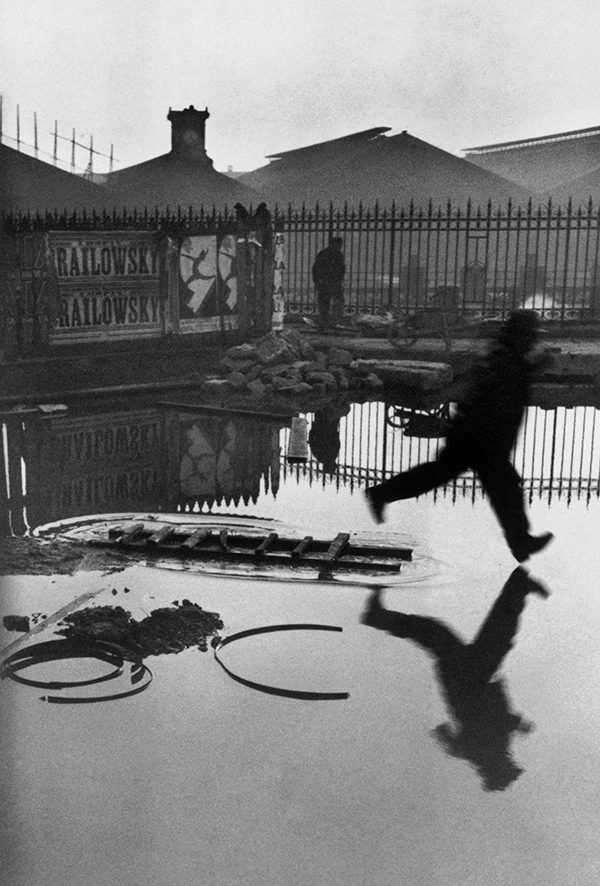Place de l’Europe Gare Saint Lazare, I932

Like many photographers of the time, Henri Cartier-Bresson (1908-1994) was born into a wealthy family, enabling him to pursue a career in what was a relatively new, and therefore unpredictable, art form.
As an art student, he made frequent trips to the Louvre museum to study the works of the masters, and young Henri was struck by the work of renaissance giants Jan van Eyck and Piero della Francesca. He also greatly admired the work of Picasso and his Cubist masterpieces, and they instilled in Cartier-Bresson the importance of a embracing a unique perspective.
His studies were cut short however, when he was conscripted into the French army in 1930, but after a year was back in Paris, and moving in circles that included Andre Breton, Max Ernst, Marcel Duchamp, Man Ray and other influential figures who were fixtures in the capital’s café society and nightlife.
His new acquaintances and their Surrealist ideas intrigued Cartier-Bresson, but he wisely listened to the advice given to him by his brilliant colleague, photographer Robert Capa: “Watch out for labels. They’re reassuring but somebody’s going to stick one on you that you’ll never get rid of – ‘the little surrealist photographer.’ You’ll be lost – you’ll get precious and mannered. Take instead the label of ‘photojournalist’ and keep the other thing for yourself, in your heart of hearts.”
He travelled to New York and secured his first photography exhibition at the legendary Julien Levy Gallery. This break inspired him, and he returned to Europe determined to capture the worsening political climate on film. World War Two was fast approaching and Cartier-Bresson joined the French military as a photographer.
Unfortunately, he was quickly captured and taken prisoner in a German labour camp. He spent three years in captivity, managing to escape on his third attempt. He quickly returned to the hiding spot where he had buried his Leica camera and retrieved it.
He was an early admirer of 35mm film, but surprisingly, Cartier-Bresson never adjusted his photographs in the darkroom; he chose to rely on the spontaneity of his images, to emphasize what he termed “the decisive moment.” This description came to epitomise the spontaneous authenticity of the shots he preferred, going so far as to wrap his Leica in black tape to make it as unobtrusive as possible as he wandered the streets. He would linger for hours observing and patiently waiting for the perfect shot, often taken unnoticed.
In 1932 he created one of his most admired photographs ‘Place de l’Europe Gare Saint Lazare’, picturing a man hopping over large puddles. It catches him in the instant before his heel hits the water – a ‘decisive moment’ filled with dynamic movement and anticipation. Wryly, behind the central figure Cartier-Bresson included a poster image of a dancer leaping enthusiastically into the air.
This type of picture took full advantage of the heightened technology that Cartier-Bresson could now draw on, with the latest advances in cameras, lenses, and film.
He was his captivating best with his picture ‘Hyéres, France’, also from 1932, a whirling commitment to his sense of perspective. In a deceptively simple composition, an arching staircase takes us spiralling down to the street, to see a cyclist caught in a blur between the architectural elements. A dramatic sense of momentum draws our eyes, darting across the spirals and curves of the guardrail.
The geometric structure of the photograph clearly stems from Cartier-Bresson’s fascination with the fractured planes of cubism. Always seeking a promising opportunity, he chose a vantage point perched at the top of the stairs to watch for activity of interest in the street below, as the cyclist happily sped by.
In 1949, Life magazine sent Cartier-Bresson to China to document the mounting turbulence as the country fell deeper into chaos. His picture ‘Shanghai’ was taken during the height of China’s civil unrest, as Mao Zedong and the People’s Liberation Army were gaining power.
The value of currency was collapsing, and in a desperate move to win favour, the existing rulers had decided to distribute 40 grams of gold to each citizen. In his extraordinary photograph, queues of frantic Chinese are seen anxiously trying to sell their gold, before Mao Zedong’s regime could pronounce gold illegal or obsolete.
The crush of bodies was typical of scenes across the country, and Cartier-Bresson cropped the picture so that the suffocating mass of bodies would appear endless. The desperation that the photograph captured so emphatically proved all too real, as he witnessed at least ten lives lost, trampled underfoot, after the picture was taken. This image became a resounding example of photography as forthright social commentary.
Cartier-Bresson would go on to join the legendary Robert Capa in co-launching the Magnum Agency in 1947, a revolutionary cooperative owned by its member photographers, linking them with potential clients around the world, and disseminating their work as widely as possible. They aimed to share a vision that would respectfully and unflinchingly chronicle world events, people, places and culture.
However, it was to be many years later that Cartier-Bresson’s work would be fully appreciated. After an exhibition at the Museum of Modern Art in New York in 1963, his achievements would finally be widely acclaimed – a remarkable pioneer of modernist photography.
His view was always clear. ‘It is an illusion that photos are made with the camera… they are made with the eye, heart and head’.
